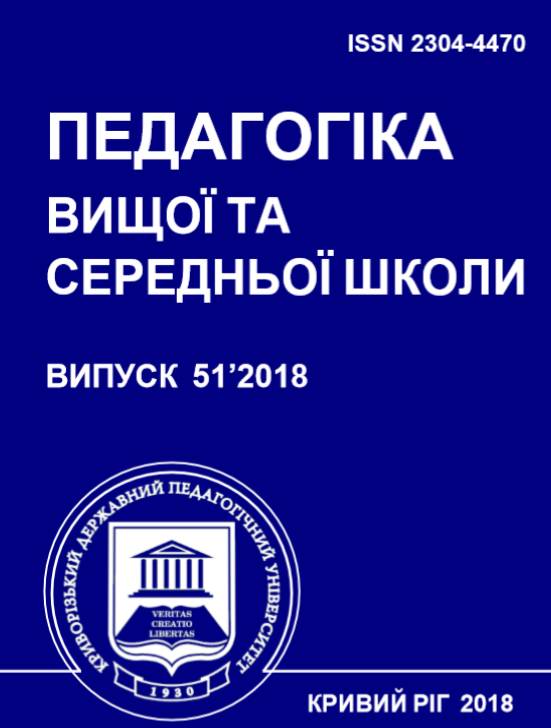Use of Augmented Reality in Chemistry Education
DOI:
https://doi.org/10.31812/pedag.v51i0.3650Keywords:
augmented reality, chemistry education, technology of the augmented reality (AR-technology), 3D modelAbstract
Nechypurenko P.P., Starova T.V., Selivanova T.V. and Tomilina A.O. Use of Augmented Reality in Chemistry Education.
The purpose of this article is to analyze the current trends in the use of the augmented reality in the chemistry education and to identify the promising areas for the introduction of AR–technologies to support the
chemistry education in Ukrainian educational institutions. The article is aimed at solving such problems as: the generalization and analysis of the scientific researches results on the use of the augmented reality in the chemistry education, the characteristics of the modern AR–tools in the chemistry education and the forecasting of some possible areas of the development and improvement of the Ukrainian tools of the augmented reality in the chemistry education. The object of research is the augmented reality, and the subject is the use of the augmented reality in the chemistry learning. As a result of the study, it has been found that AR–technologies are actively used in the chemistry education and their effectiveness has been proven, but there are still no Ukrainian software products in this field. Frequently AR–technologies
of the chemistry education are used for 3D visualization of the structure of atoms, molecules, crystalline lattices. The study has made it possible to conclude that there is a significant demand for the chemistry education with the augmented reality that is available via the mobile devices, and accordingly the need to develop the appropriate tools to support the chemistry education at schools and universities. The most promising thing is the development of methodological recommendations for the implementation of laboratory works, textbooks, popular scientific literature on chemistry with the use of the augmented reality technologies and the creation of the simulators for working
with the chemical equipment and utensils using the augmented reality.
Downloads
References
Arloon: Arloon Chemistry. https://play.google.com/store/apps/details ?id=com.Arloon.Chemistry.AR (2017). Accessed 31 Dec 2017.
Artırılmış Gerçeklik Element Kartları: AR Bilim Kartları (Augmented Reality Element Cards: AR Science Cards). Ders Zamanı Yayınları (2017).
Azuma, R., Baillot, Y., Behringer, R., Feiner, S., Julier, S., MacIntyre, B.: Recent Advances in Augmented Reality. IEEE Computer Graphics and Applications. 21 (6), 34–47 (2001). DOI: https://doi.org/10.1109/38.963459
Azuma, R. T.: A Survey of Augmented Reality. Presence: Teleoperators and Virtual Environments. 6 (4), 355–385 (1997). doi: 10.1162/pres.1997.6.4.355 DOI: https://doi.org/10.1162/pres.1997.6.4.355
Cai, S., Wang, X., Chiang, F.-K.: A case study of Augmented Reality simulation system application in a chemistry course. Computers in Human Behavior. 37, 31–40 (2014). doi: https://doi.org/10.1016/j.chb.2014.04.018 DOI: https://doi.org/10.1016/j.chb.2014.04.018
DAQRI: Elements 4D by DAQRI. https://play.google.com/store/apps/details?id=com.daqri.elements4dbydaqri&utm_source=www.apk4fun.com (2013). Accessed 31 Dec 2017.
Dáskalos: Dáskalos Chemistry: interactive science teacher for augmented reality. https://prefrontalcortex.de/labs/daskalos/periodicSystem.pdf (2015). Accessed 25 Dec 2017.
EligoVision: EV Toolbox. http://evtoolbox.ru/ (2018). Accessed 30 Jan 2018.
Fjeld, M., Fredriksson, J., Ejdestig, M., Duca, F., Botschi, K., Voegtli, B., Juchli, P.: Tangible user interface for chemistry education: comparative evaluation and re-design. In: CHI’07: Proceedings of the SIGCHI conference on Human factors in computing systems, San Jose, April 28 — May 3 2007, pp. 805–808 (2007). doi: 10.1145/1240624.1240745 DOI: https://doi.org/10.1145/1240624.1240745
Hryshchenko, M. (ed.): Nova ukrainska shkola: kontseptualni zasady reformuvannia serednoi shkoly (New Ukrainian School: Conceptual Principles for Reforming the Secondary School). Ministerstvo osvity i nauky Ukrayiny. https://mon.gov.ua/storage/app/media/zagalna%20serednya/nova-ukrainska-shkola-compressed.pdf (2016). Accessed 28 June 2017.
Iordache, D. D., Pribeanu, C., Balog, A.: Influence of specific AR capabilities on the learning effectiveness and efficiency. Studies in Informatics and Control. 21 (3), 233–240 (2012). doi: 10.24846/v21i3y201201 DOI: https://doi.org/10.24846/v21i3y201201
Larngear Technology: Atomic Structure AR Learning Gear. http://larngeartech.com/products/atomic-structure-ar-learning-gear/(2012). Accessed 31 Dec 2017.
Maier, P., Klinker, G.: Augmented chemical reactions: An augmented reality tool to support chemistry teaching. In: Proceedings 2013 2nd Experiment@ International Conference (exp.at’13), University
of Coimbra, Coimbra, 18–20 Sept. 2013, pp. 164–165 (2013). doi: 10.1109/ExpAt.2013.6703055 DOI: https://doi.org/10.1109/ExpAt.2013.6703055
Downloads
Published
Issue
Section
License
Copyright (c) 2018 Павло Нечипуренко, Тетяна Старова, Тетяна Селіванова, Анна Томіліна, Олександр Учитель

This work is licensed under a Creative Commons Attribution 4.0 International License.




